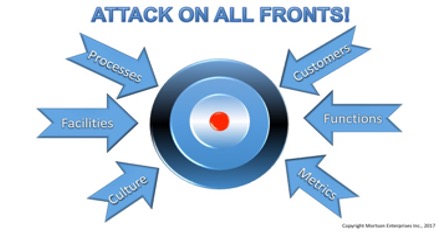For many people who work in Supply Chain Management, or for those on the outside, it functions on the foundation of processes, formulae, and metrics. This is very much the core of Supply Chain education and certification as well.
But in truth the most effective and efficient Supply Chain operations, and Supply Chain leaders, transcend these basics. How many of our current problems are because people are stuck in thinking about the mere mechanics of Supply Chain.
The best Supply Chains, and their leaders, have mastered the ART of Supply Chain Management!
Stuck in the Mechanics
It begins with Education and Certification. So many of the institutional entities that are teaching Supply Chain are focussed on the mechanics.
Course curriculum typically covers areas such as:
- Mathematics and statistics
- Quantitative analysis
- Lean and 6 Sigma
- Production control
- Inventory planning
- Logistics, warehousing and distribution
- Project management
- Systems and processes
- Finance, accounting and economics
- Procurement, purchasing, sourcing and negotiation
- Law, ethics and professionalism
A grounding in all of these areas and disciplines is excellent and mandatory for anyone looking to work in Supply Chain. A well rounded education, or certification, increases the value and the perspective that anyone will bring to their job.
Even if you choose to specialize in one area or another having an overview of all of these areas is essential. Specialists still need to have a basic understanding of other areas because it is inevitable that you will be interfacing with those people in some capacity at some point in your career.
Yet as with much academic education, the actual education value is limited if you are only learning the mechanics. For instance, when I finished my University education I felt that I was taking away more than just the course material and the grades. I had learned deep analytical skills, organizational and planning skills, learning abilities and more. Those loftier and more enlightened skills are what I would be able to apply no matter what I was doing.
I had seen this scenario play out many times in my career. There were plenty of people who were experts at the mechanics yet they did not have the skills, or the art, to achieve game changing results.
Inventory Improvement – Managing with Mechanics vs Applying the Art of Leadership
In one situation my boss asked me to lead the company’s inventory turnover improvement initiative. It was a daunting challenge and the very survival of the company required getting inventory back under control.
As I considered how I would approach this task I knew that failure was not an option. I thought about the many predecessors who had tackled inventory improvement, and failed. They were all very smart people, the understood the mechanics of Supply Chain and project management, yet their approaches always came up short.
Typically they would pick one area of Inventory Management to tackle first. Maybe it was lead times, or excess & obsolete inventory, or parameter management. They would then think about the changes they wanted to make, launch a pilot for an extended period of time, look at the results, alter their approach and attempt to roll it out more extensively.
That approach invariably took a lot of time, only looked at a microcosm of the problem, yielded few results, and made discernible difference to the overall inventory turnover performance. Not only that, but any progress that was made was never sustained because the culture and organizational sacred cows would always revert to the old ways of doing things.
They were stuck focussing on the mechanics. They failed to comprehend that there is a much larger ecosystem at play effecting the levels of inventory. They did not recognize numerous, and often conflicting, constituents, processes, resources, systems, third parties, resources and management which all played some part in determining how much inventory we had on hand.
I quickly realized that I had to approach this problem from a dramatically different perspective. I did not have the time to do pilots. I did not have the time to make changes to systems and innumerable sub-processes. I did not have the time to tackle one area at a time and progress to other areas serially. And I did not have the time to focus solely on just tweaking the mechanics.
I knew that I had to tackle the entire Inventory management ecosystem at one time. I had to consider everything holistically. I had to think beyond just sub-optimizing mechanics. I had to recognized and manage all of the dynamics and forces which impact inventory levels. Fundamentally I had to introduce the concept of change management, or change leadership, to blast through the old way of doing things and achieve breakthrough results.
I had to transcend beyond the mechanics of Supply Chain Management and apply the tool and techniques associated with the Art of Supply Chain Management.
First I sat back and mapped out, as simply, the major processes and levers which controlled the rate at which inventory flow into, through and out of the organization. I ended up with 6 major processes that needed to be led.
Then I determined that I needed to take a very holistic approach to driving this transformation; what I called the “Attack on All Fronts” approach. I had to simultaneously drive improvements across all dimensions: major processes, customers, functional areas, metrics, facilities, and finally culture

A project approach focussed solely on the optimizing the mechanics of inventory management was necessary but insufficient. A holistic approach simultaneously focussed on optimizing all of the forces and dynamics at play was necessary and sufficient.
This was the differentiation required. This was the Art of Supply Chain Management as opposed to just the mechanics of Supply Chain Management.
We focussed on fundamentally challenging and changing cultural behaviours. We attacked all of the sacred cows, all the change blockers, and all the people stuck in the old ways of doing things.
We focussed on breaking through the barriers to change. We focussed on leadership not management, major process change, on the field behaviour, and embracing the possibilities. We set stretch targets, used a top of the mountain approach, focussed on results not effort, communicated frequently and intently, and drove a process of disciplined governance.
These were the techniques and tools that were dramatically different from a mechanical approach. Changing parameters or formulae was secondary, albeit still necessary. The quantum shift to an approach focussed on holistic change leadership was the difference.
The result? In 9 months our inventory turnover performance went from being worst in the industry to number one in the industry. We took over $400 million out of inventory, improved our customer delivery performance and satisfaction, reduced inventory write-offs and carrying costs by tens of millions of dollars, increased profitability by over $25 million per year, and increased return on invested capital by over 50%.
Best of all, the results that we achieved were sustained for years to come. On top of that we had created a fundamental, positive change in the culture of the company resulting in a truly high performing organization.
The application of the Art of Supply Chain Management was the reason for this remarkable shift. If we only had just focussed on the mechanics we would have achieved the same mediocre results in the past.
It is this Art of Supply Chain Management which needs to be taught and instilled by educational and certification institutions, and further reinforced by the development programs within businesses and industries.
The Art of Supply Chain Management applied to the Future
The future of Supply Chain is the Digital Supply Chain. With a foundation of end to end, real time electronic connectivity, the Digital Supply Chain will dominate the strategies, designs and operational construct of all future businesses. Supply chain management templates will help to present it effectively.
But to create a Digital Supply Chain requires a lot of visioning and investment. And not just investment in capital.
There are numerous technologies which will be a part of this design: Blockchain, Virtual Reality, Autonomous Vehicles, Big Data, Control Towers, Predictive Analytics, Machine Learning, Robotics, Software as a Service (SaaS), Supply Chain as a Service (SCaaS), and more.
All of these technologies however are the modern day “mechanics”. Just implementing any of these will not result in the end vision of a highly functioning, advanced Supply Chain. There are too many forces that will compromise the success of these implementations if it is just a project to implement one technology or another.
You see this in many projects that fail or fall far short of expectations. Approaching a new project or system implementation “mechanically” does not recognize that human beings are involved and that cultural ways of being and long protected ways of doing things are at play. Invariably forces will conspire to stop any project from succeeding.
Success requires application of the tools and skills of the Art of Supply Chain Management. A change leadership work stream must be a core dimension of your effort. A holistic view covering all dimensions of the ecosystem must be employed. Only then do you stand a chance of making dramatic change.
The same applies to the future and the Digital Supply Chain. It is not sufficient just to implement one of these new and exciting technologies. The Art to making this successful requires an unwavering holistic approach.
Conclusion
Understanding and managing the mechanics of any Supply Chain is essential. Having a grounding in this knowledge is the basic requirement for any Supply Chain professional.
But if you want to really make ground breaking change, if you want to really achieve unprecedented results, and if you want to really advance your career and your company’s success, you must develop the skills associated with the Art of Supply Chain Management.
Holistic management, Cultural and behavioural change, and Change leadership are the core skills involved in the Art of Supply Chain Management.
To the degree that Colleges, Universities, Professional institutions, and Companies can provide opportunities to learn and apply these skills, then Supply Chains and their practitioners will succeed and stand out from the rest of the crowd.
That is the Art of Supply Chain Management!

